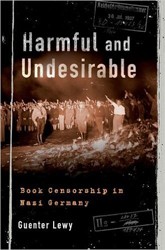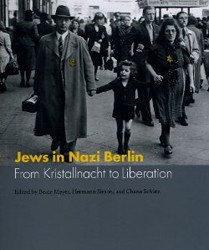Each of the seven essays in this pertinent volume looks at a different aspect of how German Jews coped with the Nazis’ statesponsored persecution. They range from moral issues of collaboration to the resourcefulness of individuals in impossible circumstances.
Francis Nicosia, one of the co-editors, looks at how Zionist agencies at first eclipsed the other German Jewish organizations in the 1930’s because of Nazi pressures for emigration, but ultimately were hobbled by the economic privations resulting from Nazi legislation against the Jews generally. Avraham Barkai’s article addresses accusations that a 1933 pact between the Zionist movement and the German government, the Haavara (Transfer) Agreement, amounted to collaboration with the Nazi regime. It allowed Jews who left Germany to reclaim their personal goods as “imports” if they moved to Palestine. Those who claimed it was collaborationist argued that a boycott of German goods could help topple the Nazi government, while implementing the transfer arrangements would help keep the Nazis in power. Barkai assembles statistics showing that notion to be far-fetched and unsupportable.
Fifty years ago the Holocaust scholar Raul Hilberg accused the leaders of the Reichsvereinigung der Juden in Deutschland, the compulsory association of German Jews, of being functionally collaborators with the Nazis (much as he saw the Judenräte of Eastern Europe). Barkai, who himself worked on a Zionist farm in Germany in 1936 – 37 in preparation for emigration, firmly rejects that conclusion. In a separate article Beate Meyer differentiates between the organization’s early years, when it oversaw welfare services for Jews and mitigated deportations, and its last years — after its leadership was deported to Theresienstadt in 1943 — when it was reduced to being an arm of the Gestapo. The Reichsvereinigung’s last functionary, Walter Lustig, was in fact shot by the Soviet occupation forces in 1945 as a Nazi collaborator.
Other essays deal with issues on a more intimate scale. Jürgen Matthäus tells how 700 Berlin Jews tried to use the legal system to get themselves reclassified as part-Aryan, often by claiming that their biological father was not their mother’s husband (very few succeeded). As Jewish men lost their professions and often their self-esteem because of anti-Jewish laws, Marion Kaplan reveals, women stepped up to take unprecedented roles in making arrangements for emigration and sometimes bargaining with the Gestapo to have their husbands released from imprisonment. The Judenhäuser, or “Jew houses,” are the subject of Konrad Kwiet’s chronicle of apartment seizures, segregation in ghetto-like buildings, dispossession,and deportation. Amazingly, some 800 Jews, generally Mischlinge (“half-Jews”) or Mischehen (those married to Aryans), were still living under Gestapo control in a hospital in Berlin at the end of the war.
Michael Brenner finds signal instances of important Jewish scholarship in Germany in the 1930’s, including three landmark works of history, as well as dissertations from a historical perspective about then-pressing issues of Jewish status and autonomy in Germany. Those works tried to address questions that persist in our own time — particularly how assimilation and emancipation, the great hopes of the German Jews, in the end failed them. Appendices, bibliography, index
Bob Goldfarb is President Emeritus of Jewish Creativity International.





